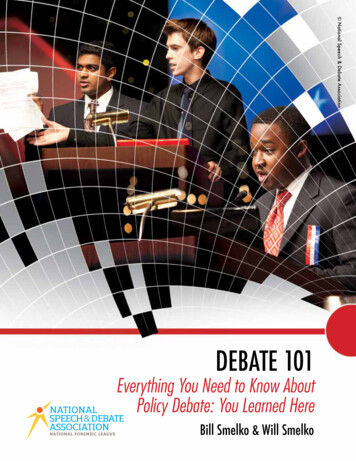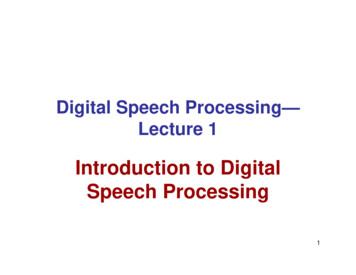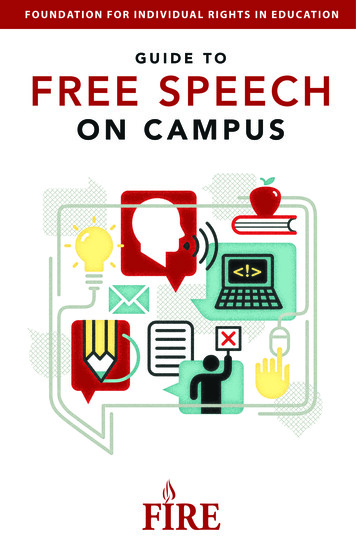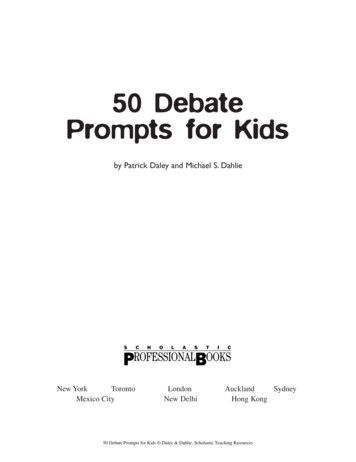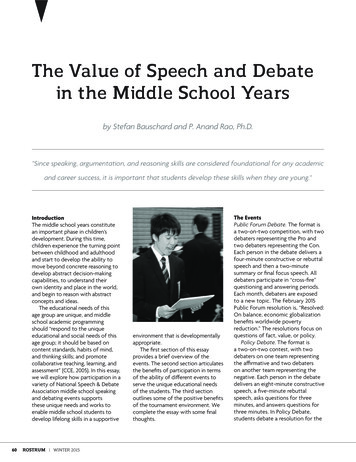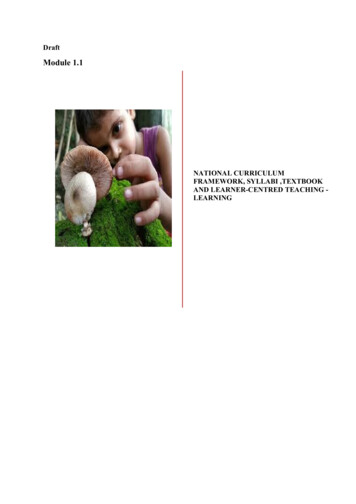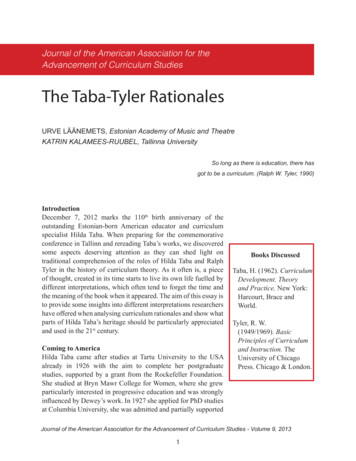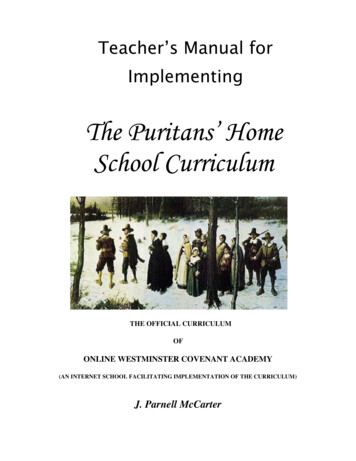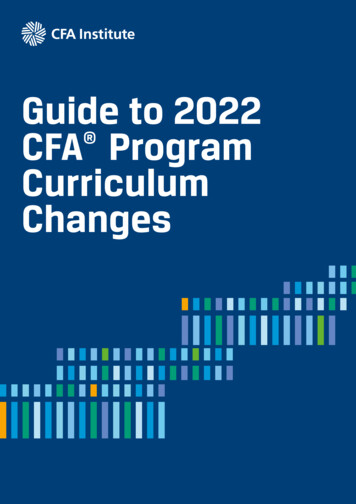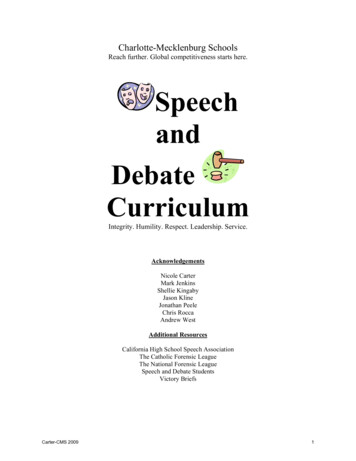
Transcription
Charlotte-Mecklenburg SchoolsReach further. Global competitiveness starts here.SpeechandDebateCurriculumIntegrity. Humility. Respect. Leadership. Service.AcknowledgementsNicole CarterMark JenkinsShellie KingabyJason KlineJonathan PeeleChris RoccaAndrew WestAdditional ResourcesCalifornia High School Speech AssociationThe Catholic Forensic LeagueThe National Forensic LeagueSpeech and Debate StudentsVictory BriefsCarter-CMS 20091
Carter-CMS 20092
Table of Contents for Speech and Debate Curriculum1. Course Descriptors for Speech and Debate2. Course Outlines for Speech and Debate3. Pacing for Speech and Debate Courses4. Course Materials for Speech and Debate Courses5. Speech and Debate Course Objectives6. Speech and Debate I: Curriculum Guide and Unit Pages7. Speech and Debate II: Curriculum Guide and Unit Pages8. Honors Speech and Debate III & IV: Curriculum Guide and Unit Pages9. Activities and Assessment Strategies for Speech and Debate Courses10. Additional Lesson Materials for Speech and Debate Courses11. Speech and Debate I: Novice Public Forum Debate Guide PDF text12. Speech and Debate II: Public Forum Debate Guide PDF text13. Victory Briefs PDF text: How to Extemp14. Victory Briefs PDF text: Advanced Extemporaneous Speaking15. Victory Briefs PDF text: How to LD16. A Guide for the Novice Coach17. NFL Coach GuideCarter-CMS 20093
Carter-CMS 20094
Introduction to the Speech and Debate Curriculum Guide“What would happen if debate became as compulsory in educational culture as football or basketball? Imaginegraduating from high school each year millions of teenagers with the ability to articulate their own needs, the needs ofothers, and the ability to offer solutions.” –Professor Edward LeeThe backbone of the Speech and Debate curriculum is the tenants of the National Forensic League’s Codeof Honor: Integrity, Humility, Respect, Leadership, and Service. Speech and Debate is a vehicle forstudents to explore the world around them and an opportunity to learn and practice the most importantlessons in life.Course Descriptors: A description of each level of the Speech and Debate curriculum.Course Outlines: A general overview of the progression of the Speech and Debate curriculum ata glance.Pacing Guide: A suggested breakdown of each unit in each class. The pacing is flexible andallows the instructor to adjust the length and arrangement of the unit as best fits the make-up ofthe class.Course Materials Guide: A suggested list of useful texts and materials for the instructor, theclass, and the individual student.Objectives: Objectives have been provided for Speech and Debate Instruction that align with thehigh school English goals of the North Carolina Department of Public Instruction. Instructorsshould select an objective that matches their planned activity for the day.Speech and Debate I Curriculum Guide and Unit Pages: This course is broken down into unitsof study. Each curriculum guide includes pacing, unit description, essential questions to guideinstruction, and the unit goals.Speech and Debate II Curriculum Guide and Unit Pages: This course is broken down intounits of study. Each curriculum guide includes pacing, unit description, essential questions toguide instruction, and the unit goals.Honors Speech and Debate III & IV: These courses are typically taught together and areconsidered advanced study. The structure of the class is more lab-style in nature and shouldinclude a mix of independent learning time as well as whole-class instruction. The curriculumguide includes pacing, unit description, essential questions to guide instruction and unit goals. Asthis course is more independently directed, some units will utilize student and instructor generatedquestions. Additionally, all units may be going on simultaneously depending on the make up ofthe class.Activities and Assessment Strategies: One of the most common concerns with a course thatrequires independent learning is the means of assessment. This guide provides assessmentoptions, instructions and suggestions as well as activities that can be used at any level of Speechand Debate study.Additional Lesson Materials: This packet of resources materials provides the Speech andDebate instructor with handouts, supplemental activities, sample student work, etc. Materialshave been compiled from a variety of sources including some of the best Speech and Debatecoaches from across the country as well as exceptional student work.Digital Textbooks: Provided are digital textbooks for the Debate disciplines for classroominstructional use.Coach Guides: These guides offer a quick reference and practical tips for classroom instructionas well as growing a Speech and Debate program and managing a team.Carter-CMS 20095
Course Descriptors for Speech and Debate CoursesSpeech and Debate IThis course explores a wide variety and range of public speaking skills, including:Extemporaneous Speaking, Declamation, Original Oratory, Oral Interpretation (prose and poetry), andStorytelling at the novice level. Additionally, students are introduced to basic researching, argumentation,questioning, and rebuttal skills through a variety and range of debate disciplines, including: CongressionalDebate, Public Forum Debate, and the basics of philosophy for Lincoln-Douglas Debate. Skill focusincludes the development of techniques in diction, articulation, enunciation and projection. Students beginto analyze pieces of literature, create and deliver orations, write arguments, and evaluate performances.Students have the opportunity to participate in local and state level Speech and Debate (Forensic)competitions.Speech and Debate IIThis course further develops skills in communication, logic, and reasoning learned in Speech andDebate I. Students continue to refine diction, articulation, enunciation and projection skills while applyingmore advanced techniques of public speaking. Students also continue to refine researching, argumentation,questioning, and rebuttal skills. Students exhibit personal responsibility through independent learning asthey specialize in at least one area of focus (event). Additionally, students exhibit team/collaborativeresponsibility and develop skills of evaluation and analysis of performances through the participation inrequired, in-class assignments. Students are expected to participate in local and state level Speech andDebate (Forensic) competitions.Honors Speech and Debate IIIThis course expands public speaking and forensic skills learned in Speech and Debate II. Studentsdemonstrate an advanced level of skill in selecting and editing quality literature, sharpening research skills,and analyzing current issues. Students polish performances in their chosen area(s) of focus (event) as wellas demonstrate an advanced level of skill in the evaluation of their own performances. Studentsdemonstrate and apply an advanced level of skill in diction, articulation, enunciation and projection.Additionally, students will participate in advanced level class activities. Honors activities may include:required/advanced reading lists, required/advanced writing assignments, projects, enrichment activities,portfolio assessment, seminar, and performance. Emphasis is placed on the application of content withinand across curricular areas. Students demonstrate advanced ability of independent learning. Students areexpected to participate in local and state level Speech and Debate (Forensic) competitions.Honors Speech and Debate IVThis course expands the fundamental and advanced skills learned in Honors Debate III. Studentsdemonstrate a superior level of skill in selecting and editing quality literature, researching methods, andanalyzing current issues. Students expertly polish performances in their chosen area(s) of focus (event) aswell as demonstrate superior skill in the evaluation of their own performances. Students will demonstratesuperior levels of skill in diction, articulation, enunciation and projection. Students also learn principals ofleadership and coaching techniques, as well as consistently demonstrate superior skills of analysis andevaluation by classmates and teammates. Additionally, students will participate in advanced level classactivities and demonstrate superior work quality. Honors activities may include: required/advanced readinglists, required/advanced writing assignments, projects, enrichment activities, portfolio assessment, seminar,and performance. Emphasis is placed on the application of content within and across curricular areas.Students demonstrate mastery of independent learning. Students are expected to participate in local andstate level Speech and Debate (Forensic) competitions.Carter-CMS 20096
Course Outlines for Speech and Debate CoursesSpeech and Debate IUnit 1: Novice Public Speaking SkillsUnit 2: Introduction to Speech and DebateUnit 3: Declamation and Speech AnalysisUnit 4: Novice Original Oratory: Topic Selection, Research, Creating a Thread, OutliningUnit 5: Novice Argumentation: Writing an ArgumentUnit 6: Novice Extemporaneous Speaking and Novice Impromptu SpeakingUnit 7: Novice Interpretation: Storytelling and Oral InterpretationUnit 8: Novice Congressional DebateUnit 9: Novice Public Forum DebateUnit 10: Novice Philosophy: Foundations of Lincoln-Douglas Debate*Instructors may opt to arrange units after Units 1 & 2 in any combination that will best suit the make-up of their particular classesor teams. The suggested order represents a logical progression of concepts that build on one another, but also provides analternation of disciplinary units between speech topics and debate topics, thus creating variety over the course of the class that givesall participants an opportunity to be engaged.Speech and Debate IIUnit 1:Unit 2:Unit 3:Unit 4:Unit 5:Unit 6:Unit 7:Intermediate Public Speaking SkillsLincoln-Douglas DebateOriginal Oratory: Crafting the OrationInterpretation: Humorous, Dramatic, and DUO InterpretationExtemporaneous SpeakingCongressional DebatePublic Forum Debate*Instructors may opt to arrange units after Unit 1 in any combination that will best suit the make-up of their particular classes orteams. The suggested order represents a logical progression of concepts that build on one another, but also provides an alternationof disciplinary units between speech topics and debate topics, thus creating variety over the course of the class that gives allparticipants an opportunity to be engaged.Honors Speech and Debate IIIHonors Speech and Debate IVUnit 1:Unit 2:Unit 3:Unit 4:Unit 5:Unit 1:Unit 2:Unit 3:Unit 4:Unit 5:Advanced Public Speaking SkillsAdvanced Debate FocusAdvanced Speech FocusPeer CoachingSpecial ProjectsAdvanced Public Speaking SkillsAdvanced Debate FocusAdvanced Speech FocusPeer CoachingSpecial Projects*Units in Speech and Debate 3 & 4 may overlap each other based upon composition of the course and the events chosen by studentsfor specific focus and/or class interest. So, Units 2-5 may all be occurring simultaneously over the span of the course. It is thedecision of the instructor how to best organize the class in order to provide students time to work on individual events as well as timefor entire class instruction on advanced topics in the Speech and Debate disciplines.**Unit 5: Special Projects is an incorporation of honors level tasks into the classroom setting. These activities may include:required/advanced reading lists, required/advanced writing assignments, projects, enrichment activities, portfolio assessment,seminar, and performance.***Units are meant to be flexible within each course, but ALL levels of Speech and Debate should begin with a Unit of PublicSpeaking in order to allow students to learn or refresh their skills and to facilitate a cooperative and supportive environment withinthe classroom setting where students feel comfortable with themselves and their peers. As this course relies heavily on presentation asa means to demonstrate learning, the opening unit on Public Speaking is essential.Carter-CMS 20097
Pacing Outlines for Speech and Debate CoursesThe pacing of units for Speech and Debate courses is dependent upon scheduling. 4 x 4 block, A/B Day, and thecombination of different levels of Speech and Debate in the same scheduling block was taken into account whenconstructing the suggested pacing of units. It is expected that on average instructors will have 90 days of courseinstruction. The pacing is meant to be flexible in order to facilitate the progression of individual classrooms/teams aswell as to provide independent work time built in. The actual length of a unit of study is instructor determined.Speech and Debate IUnit of StudyUnit 1: Novice Public Speaking SkillsUnit 2: Introduction to Speech and DebateUnit 3: Declamation and Speech AnalysisUnit 4: Novice Original Oratory: Topic Selection, Research, Creating a Thread, OutliningUnit 5: Novice Argumentation: Writing an ArgumentUnit 6: Novice Extemporaneous Speaking and Novice Impromptu SpeakingUnit 7: Novice Interpretation: Storytelling and Oral InterpretationUnit 8: Novice Congressional DebateUnit 9: Novice Public Forum DebateUnit 10: Novice Philosophy: Foundations of Lincoln-Douglas Debate*Range allows for independent student work time based on the needs of the class.Pacing/days9 - 102 -36 -75 -67 -89 - 107 -912 - 1512 - 156 -775 - 90*Instructors may opt to arrange units after Units 1 & 2 in any combination that will best suit the make-up of theirparticular classes or teams. The suggested order represents a logical progression of concepts that build on oneanother, but also provides an alternation of disciplinary units between speech topics and debate topics, thus creatingvariety over the course of the class that gives all participants an opportunity to be engaged.Speech and Debate IIUnit of StudyUnit 1: Intermediate Public Speaking SkillsUnit 2: Lincoln-Douglas Debate *recommend to begin with Lincoln-Douglas as Speech and Debate I ended with thephilosophical constructs for the foundation of Lincoln-Douglas Debate*Unit 3:Unit 4:Unit 5:Unit 6:Unit 7:Original Oratory: Crafting the OrationInterpretation: Humorous, Dramatic, and DUO InterpretationExtemporaneous SpeakingCongressional DebatePublic Forum Debate*Range allows for independent student work time based on the needs of the class.Pacing/days6 -712 - 1512129121275- 15- 15- 10- 14- 14- 90*Instructors may opt to arrange units after Unit 1 in any combination that will best suit the make-up of their particularclasses or teams. The suggested order represents a logical progression of concepts that build on one another, but alsoprovides an alternation of disciplinary units between speech topics and debate topics, thus creating variety over thecourse of the class that gives all participants an opportunity to be engaged.Carter-CMS 20098
Honors Speech and Debate IIIUnit of StudyUnit 1:Unit 2:Unit 3:Unit 4:Unit 5:Advanced Public Speaking SkillsAdvanced Debate FocusAdvanced Speech FocusPeer CoachingSpecial Projects*Range allows for independent student work time based on the needs of the class.Pacing/days7 s Speech and Debate IVUnit of StudyUnit 1:Unit 2:Unit 3:Unit 4:Unit 5:Advanced Public Speaking SkillsAdvanced Debate FocusAdvanced Speech FocusPeer CoachingSpecial Projects*Range allows for independent student work time based on the needs of the class.Pacing/days7 s in Speech and Debate 3 & 4 may overlap each other based upon composition of the course and the eventschosen by students for specific focus and/or class interest. So, Units 2-5 may all be occurring simultaneously over thespan of the course. It is the decision of the instructor how to best organize the class in order to provide students time towork on individual events as well as time for entire class instruction on advanced topics in the Speech and Debatedisciplines.**Unit 5: Special Projects is an incorporation of honors level tasks into the classroom setting. These activities mayinclude: required/advanced reading lists, required/advanced writing assignments, projects, enrichment activities,portfolio assessment, seminar, and performance.***Units are meant to be flexible within each course, but ALL levels of Speech and Debate should begin with a Unit ofPublic Speaking in order to allow students to learn or refresh their skills and to facilitate a cooperative and supportiveenvironment within the classroom setting where students feel comfortable with themselves and their peers. As thiscourse relies heavily on presentation as a means to demonstrate learning, the opening unit on Public Speaking isessential.Carter-CMS 20099
Course Materials for Speech and DebateTexts:CMS currently provides texts by Glencoe entitled Basic Debate and Strategic Debate, which may beutilized in the Speech and Debate classroom.Additional Texts not provided by CMS that are relevant to the Speech and Debate classroom:The Rostrum magazine published by the National Forensic LeagueAvery, Wayne & Webb, Linda Mastering Competitive Individual Events.Bartanen, Michael D. & Frank, David A. Lincoln-Douglas Debate: Preparing for Value Argumentation.Brown, Neil M. & Keeley, Stuart M. Asking the Right Questions: A Guide to Critical Thinking.Driscoll, William & Zompetti, Joseph. Discovering the World Through Debate.Edwards, Richard. Competitive Debate: the Official Guide.Franklin, Sharon & Clark, Deborah J. Essentials of Speech Communication.Freeley, Austin J. & Steinberg, David L. Argumentation and Debate: Critical Thinking for ReasonedDecision Making.Gamble, Terri & Gamble, Michael Oral Interpretation: Bringing Literature to Life Through Performance.Lucas, Stephen E. The Art of Public Speaking.Lunsford, Andrea A., Ruszkiewicz, John J., & Walters, Keith. Everything’s an Argument.McBride, Bill. If They Can Argue Well, They Can Write Well.NFL Library of Public Speaking and Debate Series: Introduction to Student Congress Debate by AdamJacobi; Introduction to Public Forum Debate by Jason Kline; Introduction to Lincoln-DouglasDebate by Cynthia Woodhouse; Introduction to Persuasive Public Speaking by Dixie Waldo.Oddo, Linda L. & McClain, Thomas B. Student Congress: Preparing for Legislative Debate.Rottenberg, Annette T. & Winchell, Donna Haisty. Elements of Argument: A Text and Reader.White, Fred D. & Billings, Simone J. The Well-Crafted Argument.Wiese, Jeffery & Lewis, Stan Lincoln-Douglas Debate: Values in Conflict.Yagelski, Robert P. & Miller, Robert K. The Informed Argument.Teacher/Classroom Materialsstopwatch(-es)file boxhanging filesfile foldersdictionary(-ies)thesaurus(-i)quote book(s)full length mirrorgavelmedia center accessinternet accessthe NFL offers video/DVD of events for use in the classroomStudent Materialsbinderpaper (legal pads)pens (variety of colors is useful)highlightersmaterials for personal eventsCarter-CMS 200910
Useful Source Materials**Subscriptions, library, or internet access to current event periodicals is useful.The Cato InstituteThe Huffington PostThe EconomistThe Christian-Science MonitorThe AtlanticNewsweekTimeetc.Texts for In Class Study or Outside ReadingInstructors may opt in Debate III and Debate IV to utilize an in-class text study or to assign outside readingto students. The API or Department Chair depending on the procedure for individual schools shouldapprove all assigned texts. The following is a list of texts that have been utilized in classrooms that wouldbe appropriate for study in a Speech and Debate classroom. Again, approval of a full class requiredreading is essential. This is by no means an exhaustive list, but a guide to get the instructor started.Finally, Speech and Debate is about the exchange of ideas, not all students will agree with all ideas, part ofthe lesson is learning how to address those disagreements in a logical manner. Instructors should not pushagendas of their own or decry the agendas of others in the learning environment. Some texts may havebias; again, part of the lesson is recognizing and addressing those biases with logic and reason.Bryson, Bill. A Short History of Nearly Everything.Collins, Owen. Speeches that Changed the World.Ehrenreich, Barbara. Nickel and Dimed: On NOT Getting By in America.Foster, Thomas. How to Read Literature Like a Professor.Friedman, Thomas L. The World is Flat.Friedman, Thomas L. Hot, Flat, and Crowded.Goodwin, Doris Kearns. Team of Rivals: The Political Genius of Abraham Lincoln.Heinrichs, Jay. Thank You for Arguing: What Aristotle, Lincoln, and Homer Simpson Can Teach UsAbout the Art of Persuasion.Kennedy, John F. Profiles in Courage: Decisive Moments in the Lives of Celebrated Americans.Levitt, Steven D. & Dubner, Stephen J. Freakonomics: A Rogue Economist Explores the Hidden Side ofEverything.Obama, Barak. The Audacity of Hope: Thoughts on Reclaiming the American Dream.Schlosser, Eric. Fast Food Nation.Weber, Karl. Food Inc.: A Participant’s Guide: How Industrial Food is Making Us Sicker, Fatter, andPoorer-And What You Can Do About It.Zinn, Howard. A People’s History of the United States.Carter-CMS 200911
Speech and Debate Course ObjectivesThe North Carolina Department of Public Instruction does not outline objectives for Speech and Debateinstruction. The following objectives for Speech and Debate have been aligned to current objectives forother core subject areas, specifically English/Language Arts.Speech and Debate I – IV ObjectivesEnglish IVCompetency Goal 1The learner will express reflections and reactions to print and non-print text as well asto personal experience.1.01 Compose reflective texts that give the audience:*an understanding of complex thoughts and feelings.*a sense of significance (social, political, or philosophical implications).*a sense of encouragement to reflect on his or her own ideas.1.02 Respond to texts so that the audience will:*empathize with the voice of the text.*make connections between the learner's life and the text reflect on how cultural orhistorical perspectives may have influenced these responses.*examine the learner's own response in light of peers' responses recognize featuresof the author's use of language and how the learner relates these features tohis/her own writing.English IICompetency Goal 2The learner will evaluate problems, examine cause/effect relationships, and answerresearch questions to inform an audience.2.01 Demonstrate the ability to read, listen to and view a variety of increasinglycomplex print and non-printinformational texts by:*selecting, monitoring, and modifying as necessary reading strategies appropriateto readers' purpose.*identifying and analyzing text components (such as organizational structures,story elements, organizational features) and evaluating their impact on the text.*providing textual evidence to support understanding of and reader's response totext.*demonstrating comprehension of main idea and supporting details.*summarizing key events and/or points from text.*making inferences, predicting, and drawing conclusions based on text.*identifying and analyzing personal, social, historical or cultural influences,contexts, or biases.*making connections between works, self and related topics.*analyzing and evaluating the effects of author's craft and style.*analyzing and evaluating the connections or relationships between and amongideas, concepts, characterand/or experiences.*identifying and analyzing elements of informational environment found in text inlight of purpose, audience, and context.2.02 Create responses that examine a cause/effect relationship among events by:*effectively summarizing situations.*showing a clear, logical connection among events.*logically organizing connections by transitioning between points.*developing appropriate strategies such as graphics, essays, and multimediapresentations to illustrate points.2.03 Pose questions prompted by texts and research answers by:*accessing information or explanations from print and non-print media sources.*prioritizing and organizing information to construct a complete and reasonableexplanation.Carter-CMS 200912
English IIICompetency Goal 3The learner will examine argumentation and develop informed opinions3.01 Use language persuasively in addressing a particular issue by:*finding and interpreting information effectively.*recognizing propaganda as a purposeful technique.*establishing and defending a point of view.*responding respectfully to viewpoints and biases.3.02 Select an issue or theme and take a stance on that issue by:*supporting the argument with specific reasons.3.03 Use argumentation for:*interpreting researched information effectively.*establishing and defending a point of view.*addressing concerns of the opposition.*using logical strategies (e.g., deductive and inductive reasoning, syllogisms,analogies) and sophisticated techniques (e.g., rhetorical devices, parallelism, irony,concrete images).*developing a sense of completion.3.04 Demonstrate the ability to read, listen to and view a variety of increasinglycomplex print and non-print argumentative texts by:*selecting, monitoring, and modifying as necessary reading strategies appropriate toreaders' purpose.*identifying and analyzing text components (such as organizational structures, storyelements, organizational features) and evaluating their impact on the text.*providing textual evidence to support understanding of and reader's response totext.*demonstrating comprehension of main idea and supporting details.*summarizing key events and/or points from text.*making inferences, predicting, and drawing conclusions based on text.*identifying and analyzing personal, social, historical or cultural influences,contexts, or biases.*making connections between works, self and related topics.*analyzing and evaluating the effects of author's craft and style.*analyzing and evaluating the connections or relationships between and amongideas, concepts, characters and/or experiences.*identifying and analyzing elements of argumentative environment found in text inlight of purpose, audience, and context.English ICompetency Goal 4The learner will create and use standards to critique communication.4.01 Evaluate the effectiveness of communication by:*examining the use of strategies in a presentation/product.*applying a set of predetermined standards.*creating an additional set of standards and applying them to the presentation/product.*comparing effective strategies used in different presentations/products.4.02 Read and critique various genres by:*using preparation, engagement, and reflection strategies appropriate for the text.*identifying and using standards to evaluate aspects of the work or the work as aCarter-CMS 200913
whole.*judging the impact of different stylistic and literary devices on the work.English ICompetency Goal 5The learner will demonstrate understanding of various literary genres, concepts,elements, and terms.5.01 Read and analyze various literary works by:*using effective reading strategies for preparation, engagement, reflection.*recognizing and analyzing the characteristics of literary genres, including fiction (e.g.,myths, legends, shortstories, novels), nonfiction (e.g., essays, biographies, autobiographies, historicaldocuments), poetry (e.g.,epics, sonnets, lyric poetry, ballads) and drama (e.g., tragedy, comedy).*interpreting literary devices such as allusion, symbolism, figurative language,flashback, dramatic irony,dialogue, diction, and imagery.*understanding the importance of tone, mood, diction, and style.*explaining and interpreting archetypal characters, themes, settings.*explaining how point of view is developed and its effect on literary texts.*determining a character's traits from his/her actions, speech, appearance, or whatothers say about him or her.*explaining how the writer creates character, setting, motif, theme, and other elements.*making thematic connections among literary texts and media and contemporary issues.*understanding the importance of cultural and historical impact on literary texts.*producing creative responses that follow the conventions of a specific genre andusing appropriate literary devices for that genre.English IICompetency Goal 6The learner will apply conventions of grammar and language usage.6.01 Demonstrate an understanding of conventional written and spoken expression by:*employing varying sentence structures (e.g., inversion, introductory phrases) andsentence types (e.g.,* simple, compound, complex, compound-complex).*analyzing authors' choice of words, sentence structure, and use of language.*using vocabulary strategies such as context clues, resources, and structuralanalysis (roots, prefixes, etc.) to determine meaning of words and phrases.*examining textual and classroom language for elements such as idioms,denotation, and connotation to apply effectively in own writing/speaking.*using correct form/format for essays, business letters, research papers,bibliographies.*using language effectively to create mood and tone.6.02 Edit for:*subject-verb agreement, tense choice, pronoun usage, clear antecedents, correctcase, and complete sentences.*appropriate and correct mechanics (commas, italics, underlining, semicolon,colon, apostrophe, quotation marks).*parallel structure.*clichés trite expressions.*spelling.Additional Objectives for Honors Speech and Debate III & IVAP EnglishCarter-CMS 2009The learner will reflect on and express reactions to print and non-print sources.14
LiteratureCompetency Goal 11.01 Compose reflective texts to:*express an understanding of complex thoughts and feelings.*convey a sense of social, historical, political, philosophical, and/or stylisticimplications.*articulate his/her own values and preferences with respect to both the style andsubstance of other individuals.1.02 Respond to resources to demonstrate an understanding of cultural, historical,and/or social implications with precision, sensitivity, energ
Carter-CMS 2009 7. Pacing Outlines for Speech and Debate Courses The pacing of units for Speech and Debate courses is dependent upon scheduling. 4 x 4 block, A/B Day, and the combination of different levels of Speech and Debate
